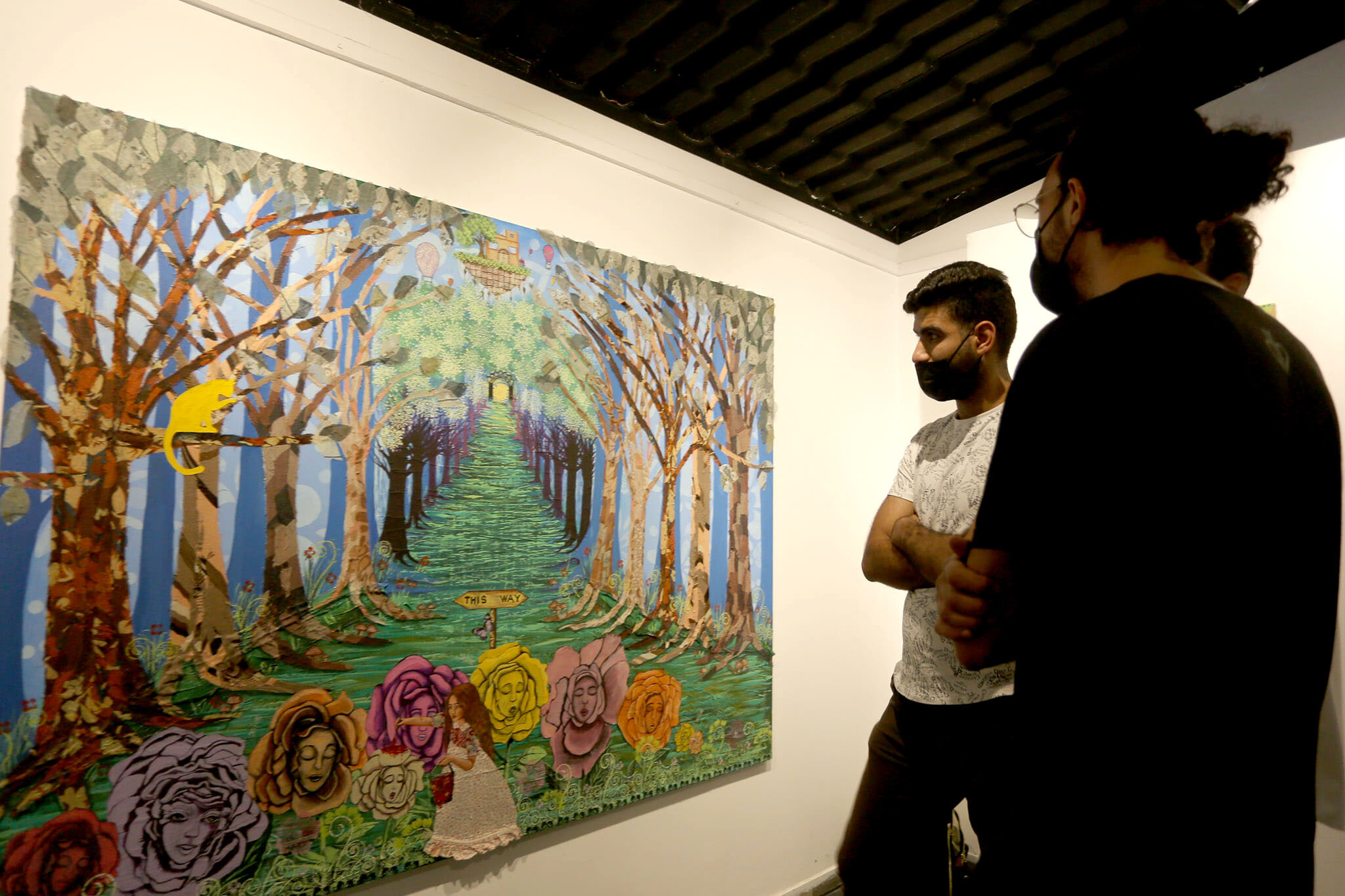
Yara Chaalan
Established in 2009 by younger professional artists of Gaza, Shababek Gallery for Contemporary Art is a nonprofit space that specializes in exhibiting contemporary art.
It presents the artwork of Palestinian artists residing in the Gaza Strip through its exhibition hall and diverse online platforms.
With declining opportunities for exhibitions and art sales, the art scene in the Gaza Strip has been deteriorating over the past 20 years. There are many reasons for this, explains cofounder and artist Shareef Sarhan, among them the imposed siege, economic recession, a lack of government support, and political divisions. These aggravated conditions have resulted in a lack of attention towards arts in general, and discouraged artists to pursue their passion and art work.
Aside from the gloomy reality of the region and Gaza’s deteriorating living conditions, young artists here are challenged with so many obstacles that prevent them from publishing or conducting their first exhibits. There are a limited number of organizations providing support to contemporary arts, and most artists lack the financial ability to stage their own shows.
Shababek uses its resources to support young and emerging new artists by providing them the opportunity to conduct their first-ever art exhibition. This is intended to bolster the art movement in the Gaza Strip, and introduce the untold story of Gaza through art to the world.
The good news is that Shababek works on strengthening young artists by helping them to develop their contemporary tools and mediums through their participation in exhibitions, workshops, meetings, residences, and through offering production grants.
The program provides art residencies in dedicated studios at the “Windows for Contemporary Art” headquarters. Residencies extend over a period of three months, with the provision of a financial sum for the implementation and development of an art project during the artist’s residency, in addition to logistical support and a dedicated work environment, along with a number of books and technical references provided by the Shababek Library. It is an empowering opportunity for those who do not have their own studio in which to work.
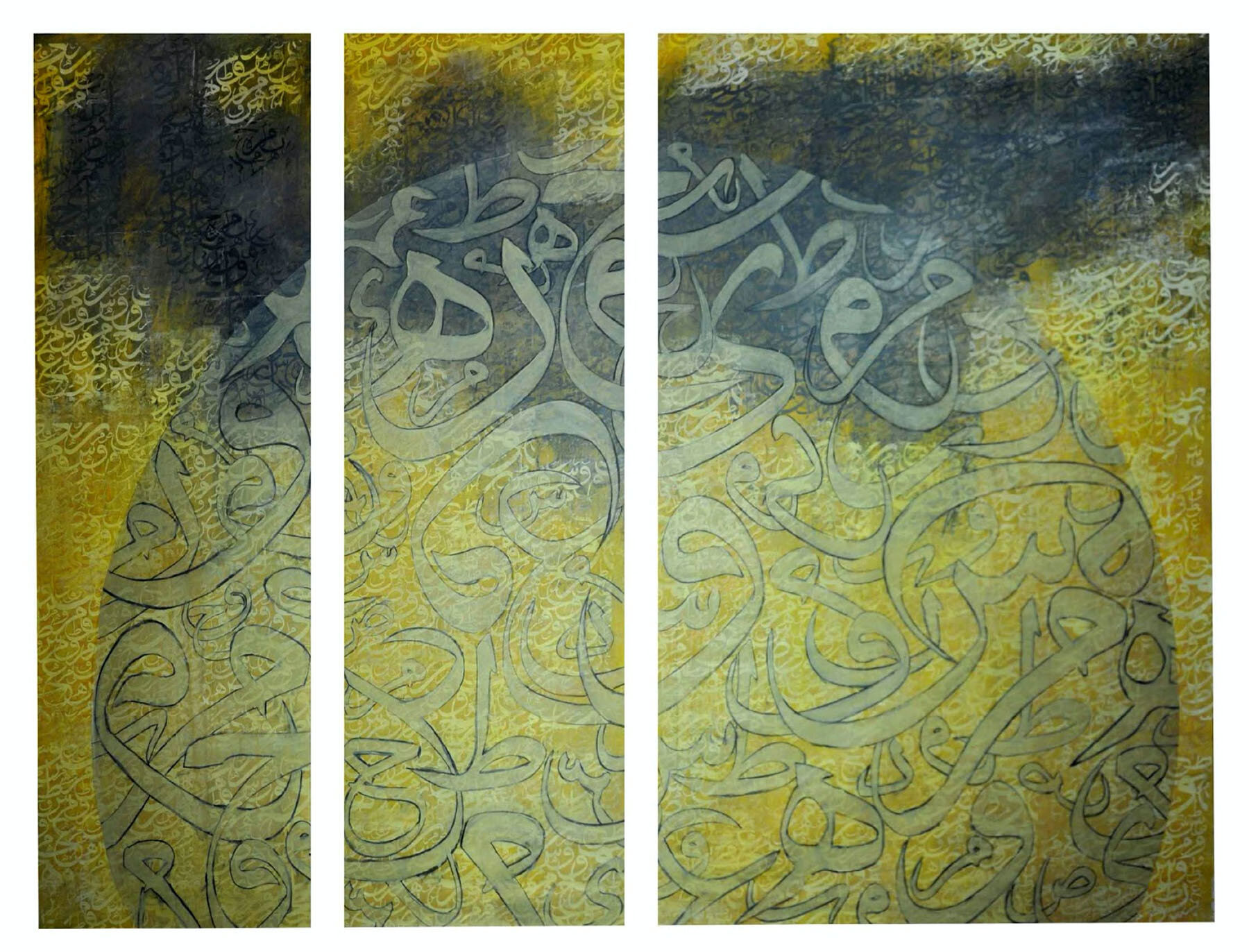
“Letters 1, 2018,” 185 x 155 cm, Shareef Sarhan.
About the Artists
Shareef Sarhan — Born in Gaza in 1976, Sharif Sarhan works as an artist, professional photographer and free-lance designer. He is a founding member of the Windows from Gaza for Contemporary Art group and an active member of the Association of Palestinian Artists. Sarhan has a diploma in arts from the University of ICS in the United States. He had participated in several art training courses and workshops. He was involved in the activities of the September Dara Academy of Jordanian Arts from 2000 to 2003 under the supervision of Syrian-German artist Marwan Kassab Bashi. Sarhan had introduced his works in many individual and group exhibitions in Gaza in the Arts and Crafts village, the Port Gallery, and exhibited some of his works in Ramallah, Bethlehem, Jerusalem, Amman, Britain, the United States, Sharjah and Cairo.
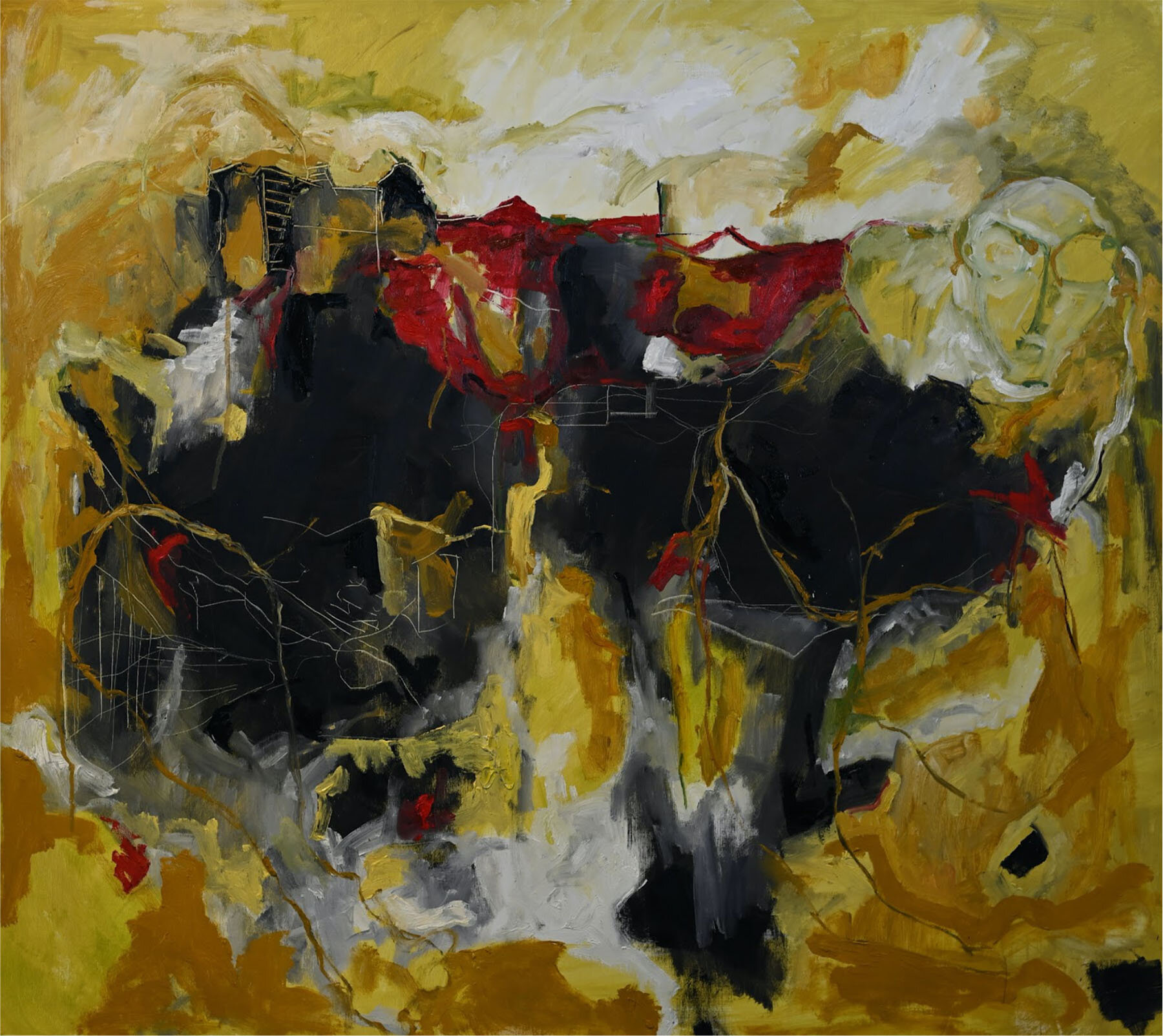
“Untitled” 2020, oil on canvas, 90 x 104 cm, Majdal Nateel.
Majdal Nateel is a visual artist who lives and works in the Gaza Strip. She was awarded her BA in Fine Arts from Al-Aqsa University, and along with her artistic research, she has worked as a drama trainer and as an assistant teacher for different art courses at the Gaza Training College – UNRWA (GTC). She’s also worked in animation with children and is now an art teacher at the Rosary Sisters School. In addition, she has participated in several exhibitions and art auctions.
Majdal Nateel has produced a body of works on the theme of amputation. The artist has carried out some profound field research based on interviews with survivors of Gaza’s Great March of Return. Although her theme in the research was amputation, elements of direct violence or injured and lost body parts, are rarely actually seen. However, the feeling of profound unease and loss is present throughout the work, largely through the parallelism between the loss of limb and the loss of home.
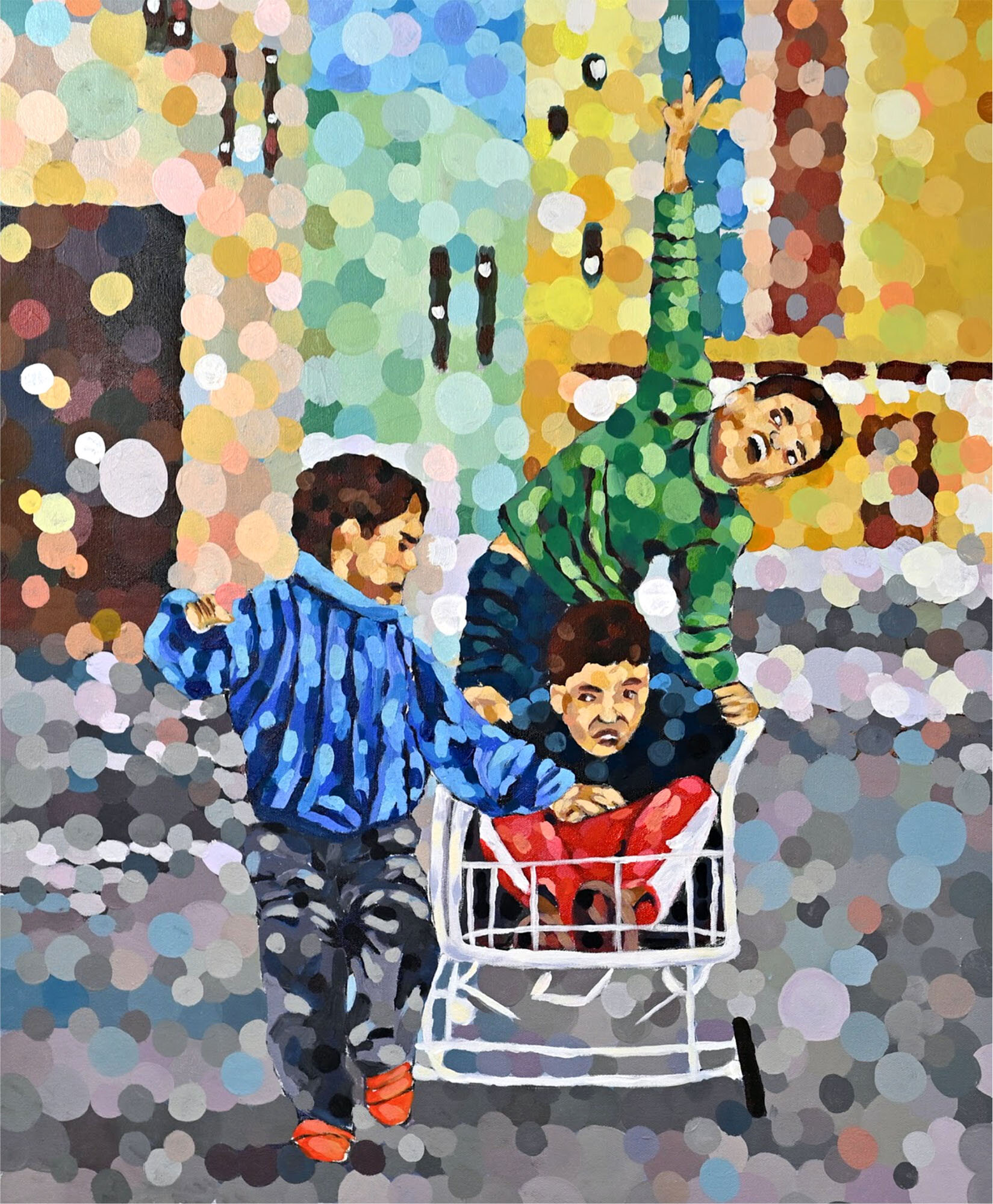
“Innocence” 2020, acrylic on canvas, 70 x 60 cm, Mohamad AlKrunz.
Mohamad AlKrunz was born in Jordan, and now lives and works in Al-Bureij camp, Gaza. Although he holds a BA in sociology and political science, he currently works as a professional visual artist. He experiments with both realism and symbolic realism, and he has a unique style combining pointillism with impressionist tendencies. He has participated in many exhibitions and competitions, and had his solo exhibition, “It Was Beautiful” in the YMCA hall in Gaza in 2017.
His series of paintings tackle the social, humanitarian, and economic aspects of Palestinian refugee camps. Since these camps are overcrowded, their members have resorted to expanding the camp’s outer edges into the agricultural land that serves as the camp’s food basket. This is what the artist refers to as the “Camp Countryside.”
The project presents the marginalized life from the perspective of someone who grew up in the harsh and difficult conditions of a refugee camp and witnessed firsthand the transformation of the Camp Countryside from a lush green to a dull gray. The artist hopes that through this project, his work can help save the ‘camp countryside’ by shedding light on the problem.
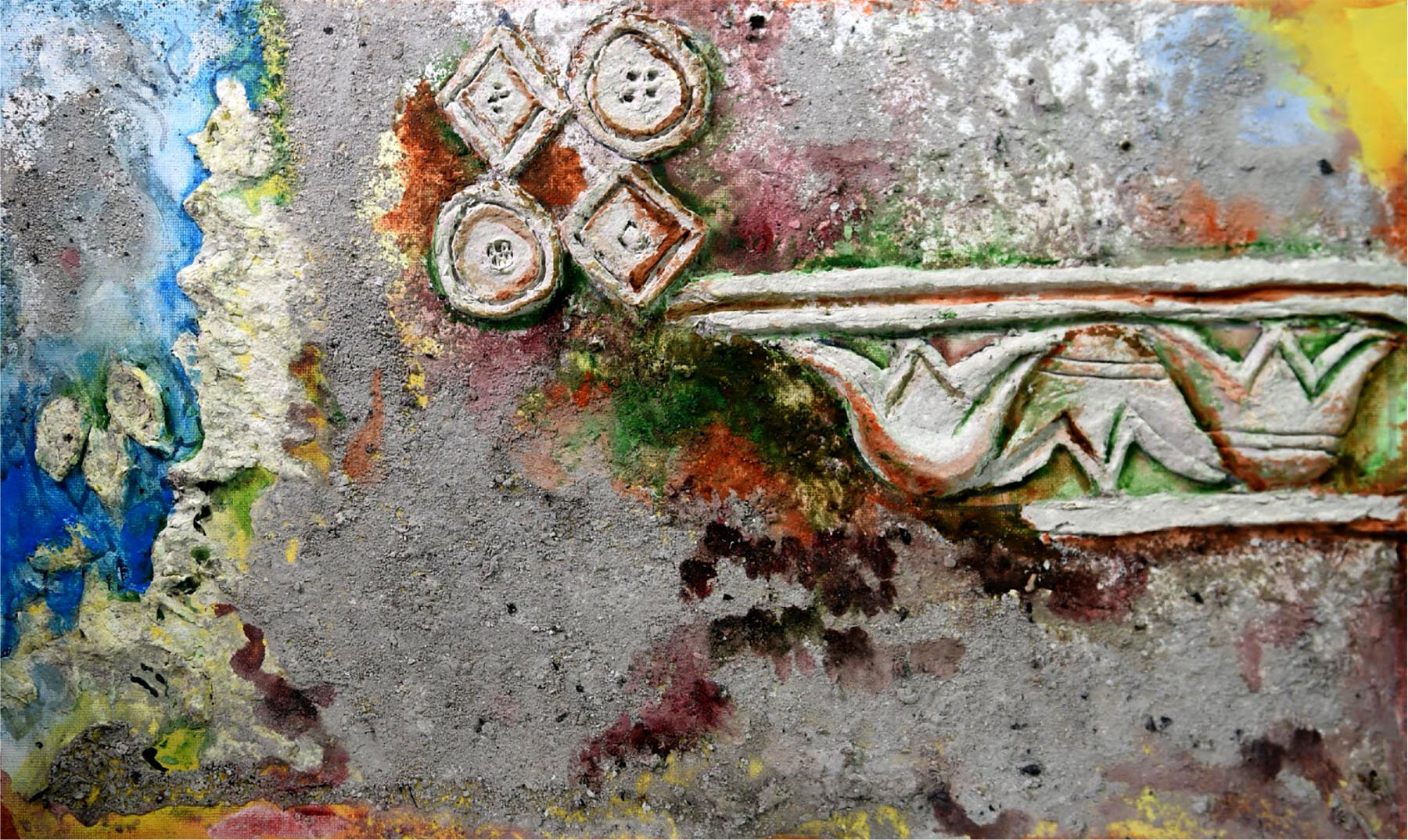
“History of Palestine,” 2019, ashes on canvas and other materials, 35 x 30 x 1.5 cm, Rana Al-Batrawi
Rana Al-Batrawi was born in Gaza in 1983. She received her BA in Arts Education from Al-Aqsa University. She works in various art domains and is particularly interested in sculpting. She presented her work in two solo exhibitions: “The Cactus Flower” (2011) and “The Earth’s Ember” (2016). She has participated in several exhibitions, workshops and festivals between 2004 and 2018 in several cities both in Palestine and abroad.
Her project “Ashes and Clay” is part of a research that explores the formation of different materials as a visual representation depicting color connotations. “I was drawn by the resemblance of the color of ashes and the varied meanings they uphold,” she says. “The ashes retain the basic organic matter of what was burned, and thus I chose the ashes of fruits, wood, herbs, and other materials as my artistic media. I also chose to use clay to form contemporary sculptures, inspired by the scenes of the Palestinian coast, Jerusalem, the mountains of Palestine and its cities. The project is largely a reflection of the contrasts of life in Palestine. We were born from mud and clay, and yet daily, we live in a country of ash.”
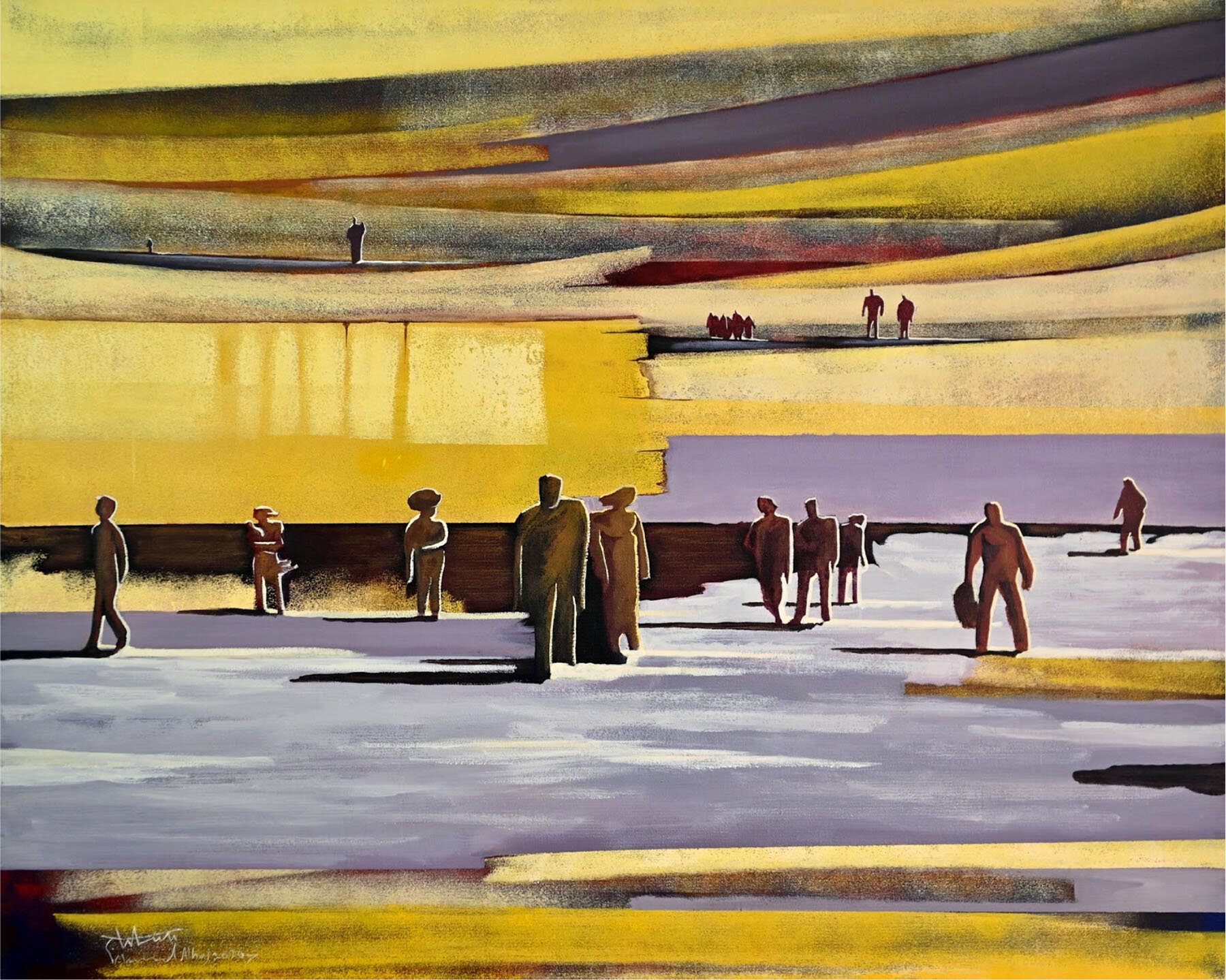
Untitled, 2020, acrylic on canvas 100 x 80 cm, Mohammed AlHaj.
Mohamad AlHaj — Born in Libya in 1982, Mohammed Al Haj is a Palestinian refugee from the village of Kawkaba. Al Haj graduated with a BA in Art Education from Al Aqsa University in Gaza City in 2004. He is a founding member of the Palestinian Visual Artists Association in Gaza and one of its administrative members, and a member of the Paletta Contemporary Art Group. His painting style varies from one school of art to another, from abstraction to expressionism to paintings that are “pop art” in nature. He has participated in exhibitions and festivals both inside and outside of Palestine. As a young artist from Gaza, Al Haj represents a perfect exemplar when talking about young, contemporary visual art experiences in a city that suffers from almost complete disconnection from the rest of Palestine, from the rest of the Arab world and the wider global surroundings and where the challenges facing Palestinian artists in general take on a more complex and difficult form in a place burdened by the manifestations of war, siege and division which profoundly affect young artists.
It was through the stark reality of the challenges the Arab region is going through, especially in Palestine, and with the successive political tensions, that the idea of Intiqal was born to serve as evidence for the impact mass displacement has had on a population in search of stability of life in a safe and neutral environment. It also serves as a study of the perceived body language of those displaced in foreign lands, as well as the individual and group human psychologies that can be seen in the process of transit and as a response to mass displacement. With the artistic concept of radiative formations in mind, Intiqal was inspired by the vista of human masses segmented into groups and individuals, which would explain how the concept came to be an expressive philosophy, in a symbolic and aesthetic sense, giving continuous movement and dynamism in time and space to the paintings in which it appears.
From one perspective, the human shadow is the horizon that carries memories of the past and aspirations for the future, and from another, it is the study of movement and space that are both in constant change due to the persistence and continued appearance of this scene of mass displacement. The core message of this project comes in the form of an inquiry about fate and the future, and about when this scene of mass displacement – which repeats itself almost daily now in various places and several times across the media – will end, and, lastly, about how one can confront and address this through art as an imagined visual language.
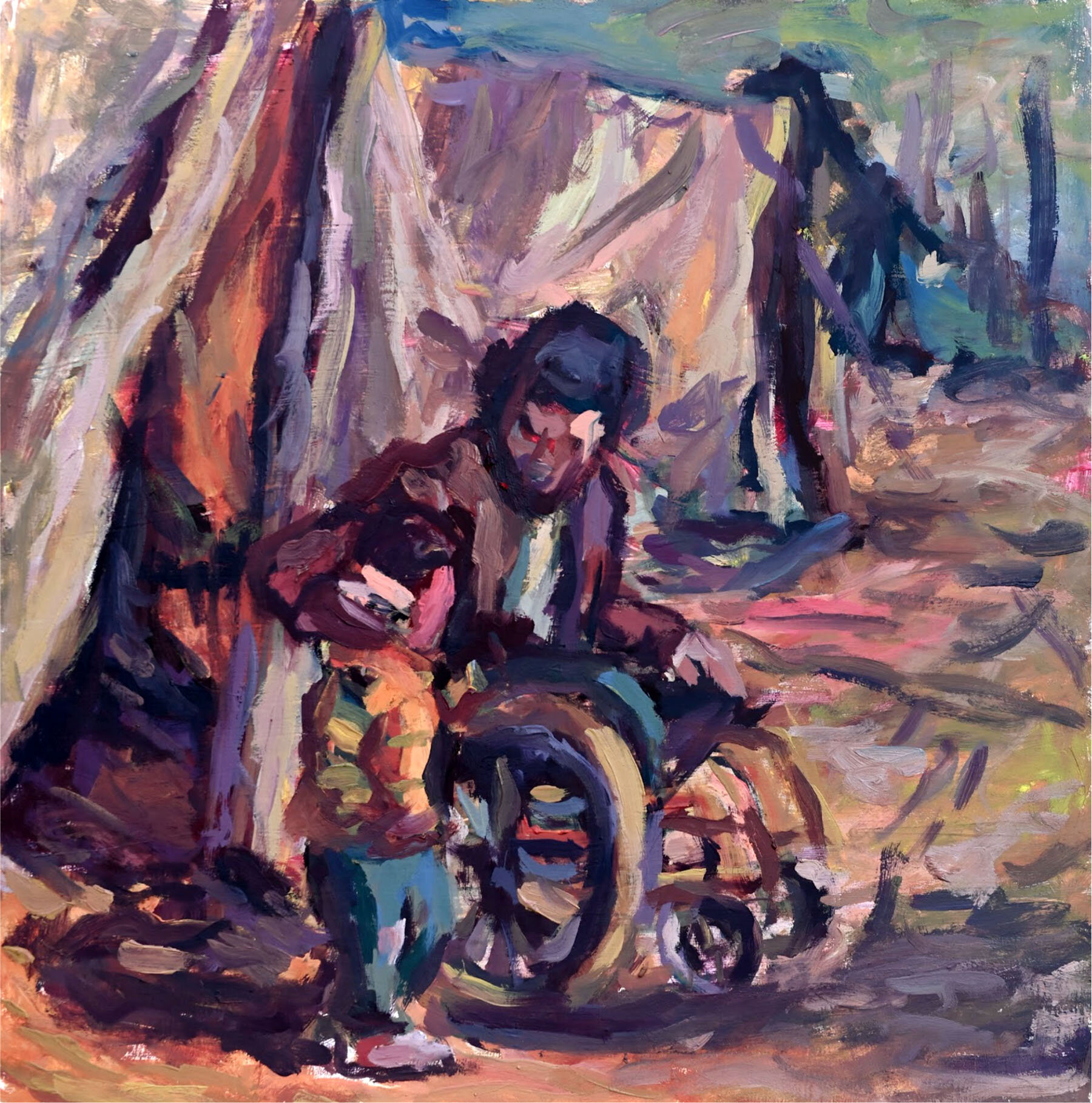
“Untitled,” 2020, oil on canvas, 60 x 60 cm, Ruqaia Al Lulu.
Ruqaia Al Lulu — Graduating in 1998, Ruqaia earned her BA in Photography from An-Najah National University in Nablus. In 2006 she obtained her Masters, also in Photography, from Helwan University in Cairo, Egypt. She now works at the Ministry of Education. She participated in multiple group exhibitions such as “Palestine is a Dream to Come True in Gaza,” “A Man and a Chair in Cairo,” and “Our Life in Gaza” in Jordan. She held her solo exhibition “Beneath the Sky” at the Eltiqa Gallery in 2012, the Shaghaf Exhibition in 2016 and the Jakar Exhibition at the Shababek Gallery, in 2018.
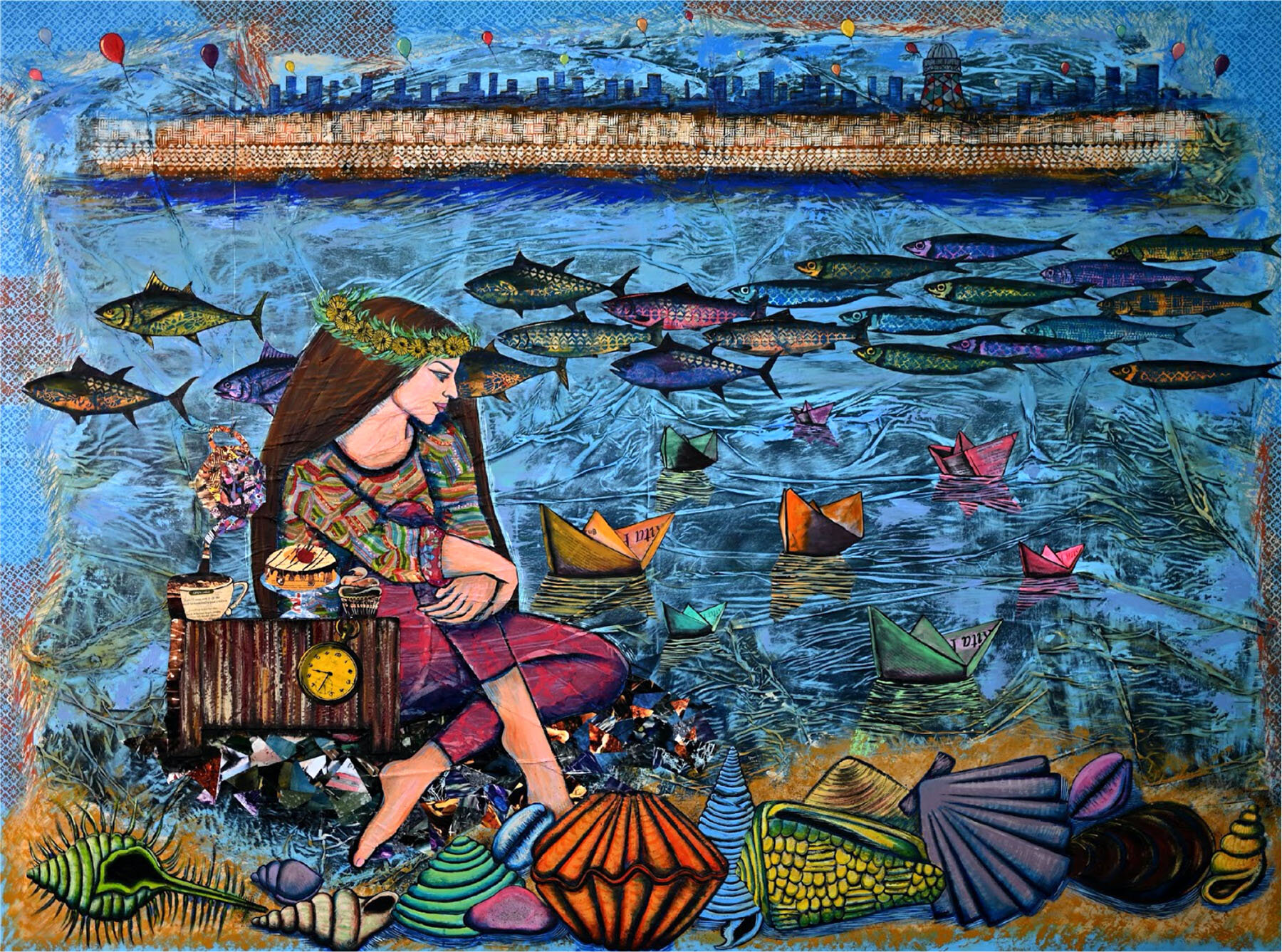
“Alice in Palestine” #1, 2021, acrylic and mixed media on canvas, 200 x 150 cm, Maysa Yousef.
Maysa Yousef was born in 1984 in al-Shati’ Camp, Gaza. She holds a higher diploma in military medical nursing, and she worked at the Balsam Military Hospital. Yousef also has a BFA in painting from al-Aqsa University alongside many certificates in the fields of health, painting, photography, arabesque, graphic design and modern and contemporary art. She participated in many contemporary art workshops, including Cultivating Young Talents, Art Spring, Artists for Palestine and Sbat al-Alami, and in painting several murals. Her work has been featured in several local and international exhibitions and venues, including the International Milad Festival in collaboration with the Elteqaa Group, the French Cultural Centre, the Culture and Free Idea Society in Gaza, and the Khalil Sakakini Cultural Centre in Ramallah.
She is a member of the Palestinian Visual Artists Association, Europe, and the Plastic Artists Association, Morocco. She has exhibited in many Arab countries, including Egypt, Kuwait, Jordan, Dubai and Morocco, as well as Germany, the UK and the United States. Yousif’s artworks belong to the school of magical realism and primarily use collage, a technique she has developed since the beginning of her career. She still experiments with new material to add unique character to her work.
“Alice in Palestine” was Yousif’s first solo exhibition, conceived after many experiments and attempts to create the finished work.
With this work of art, Maysa liberated paper scraps and canvases from their tangible restrictions and monotonous representations. She takes her medium to another world and returns with artwork charger with strong and framed by sweeping contexts. It is an escape from presence to absence, from rational to the imaginary, from the limited to the absolute. She triggers sudden transition, from a common point of departure in meaning to a new creative significance. This work carries the viewer between two worlds through a mediator, created by a convergence of several materials on the work, thus creating a most powerful reality with a completely different sensory experience resembling a reverie.
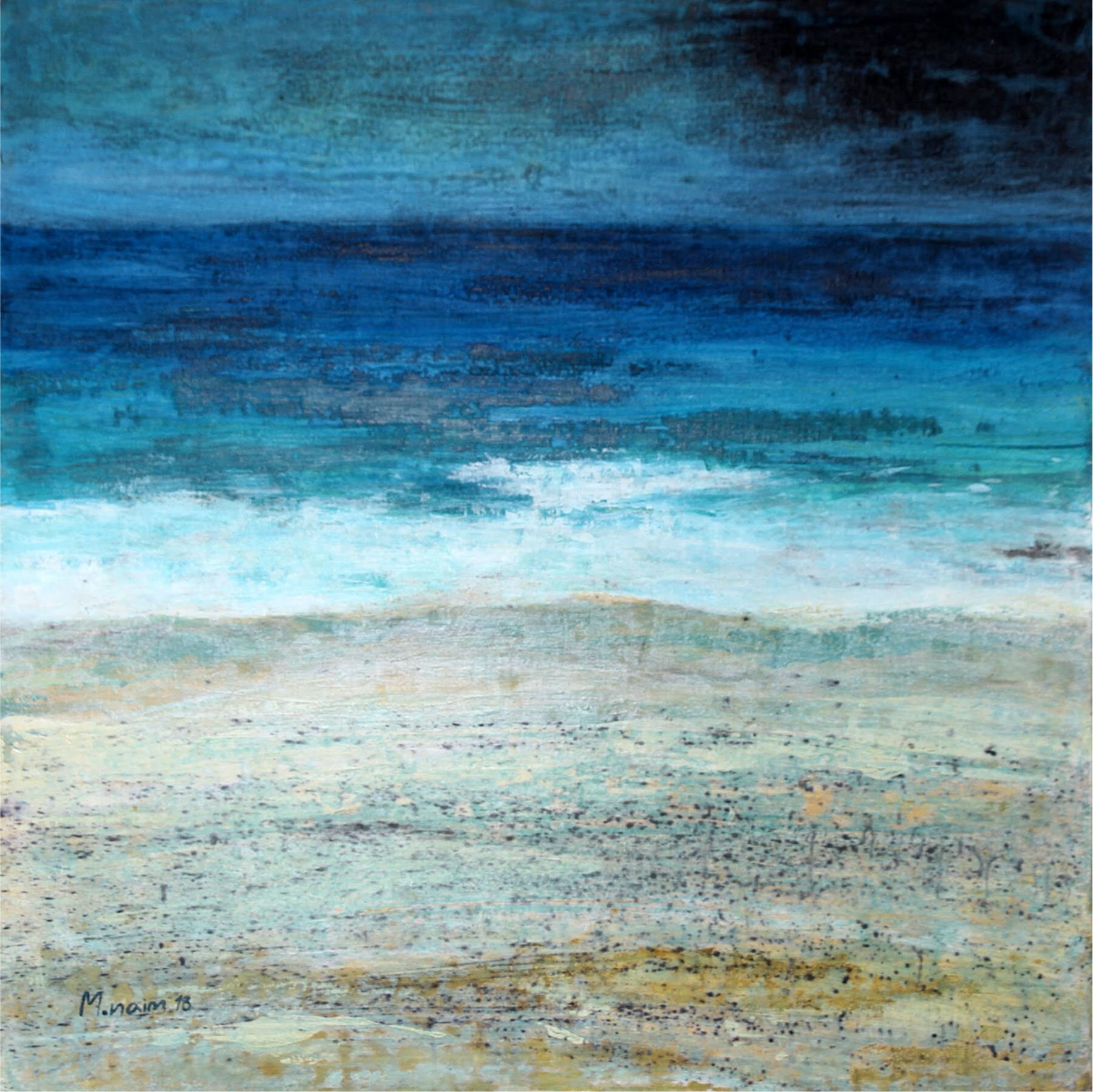
“Untitled,” 2018, acrylic on canvas, 75 x 75 cm, Motaz Naim.
Motaz Naim is a Palestinian Artist residing in the northern Gaza Strip. Born in Damascus Syria 1973, he has a Bachelor of Fine Arts, 1997 Damascus University/Syria Member of the General Union of Palestinian Plastic Artists. He has many displays in art exhibitions and festivals in Palestine and abroad. His works are based in Palestine, Jordan, Kuwait, Syria, the UAE and other countries. He has participated in several art auctions and special art exhibitions, and he has won several awards in plastic art. Lecturer in Art, Faculty of Science and Technology, Khan Younis, Gaza Strip Full time for plastic work. Over the past years, many works of art have been presented that show their styles influenced by the Impressionist and Expressionist schools, in addition to abstract expressionism. Where the work of the artist is inspired by the place’s wide and varied views, between nature, sea, village, city and camp.
The works of the Palestinian artist Motaz Naim are inspired by the vastness and diversity of the place, including its nature, sea, village, city and camp. The artist was born and raised in Yarmouk refugee camp in Syria and has been living in Gaza strip since 1997. over the past few years, he presented many works of art influenced by impressionist and expressionist styles, in addition to abstract expressionism. Naim does not focus on the details of the overall landscape, but rather showcases the aesthetic and integrality of the place though color gradient, and his sensory transparent style.
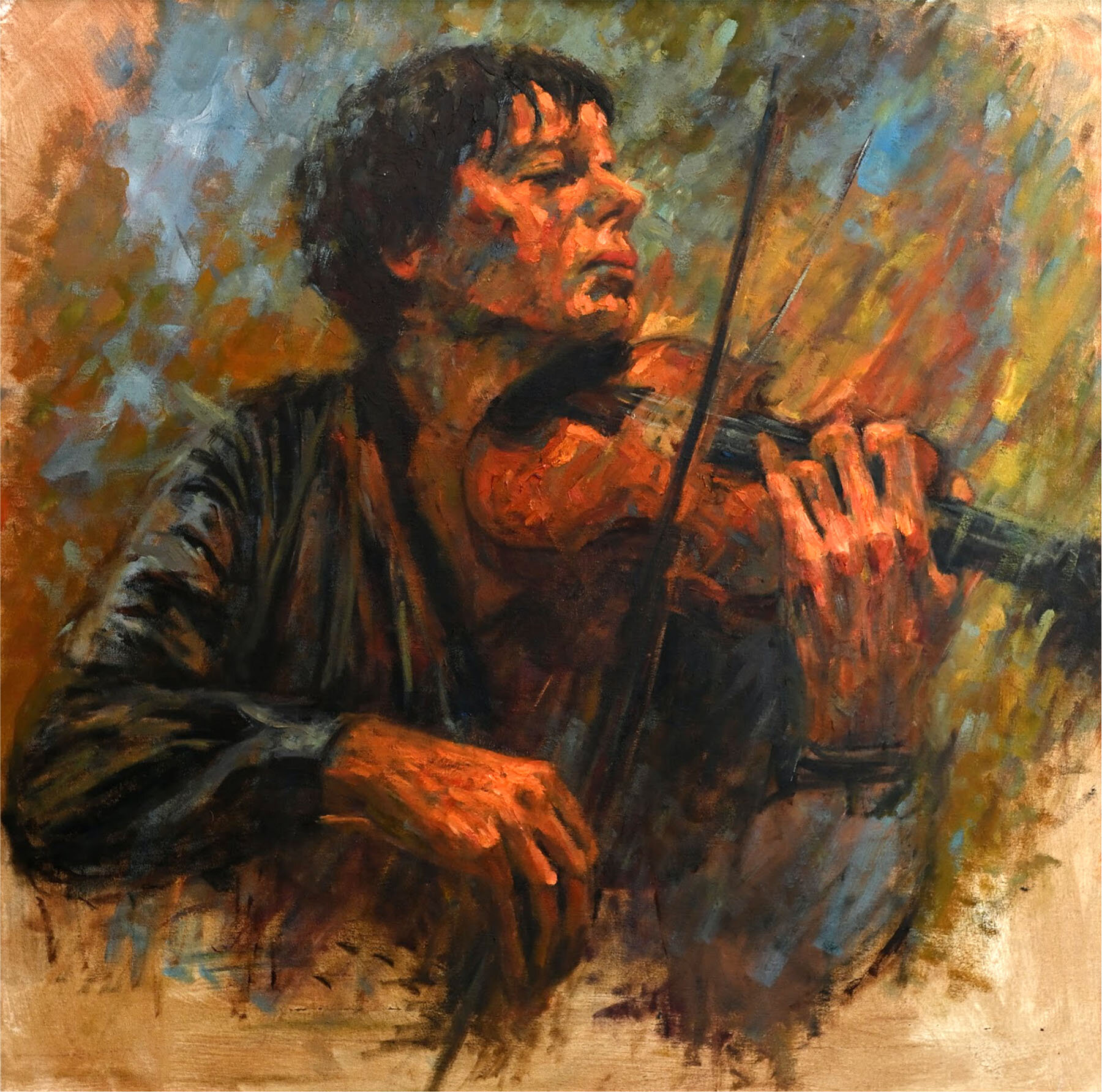
“The Violin,” 2020, oil on canvas, 80 x 80 cm, Ibrahim Al-Awadi.
Ibrahim Al-Awadi was born in Jabalia Camp in 1976. He holds a BA in Art Education from Al Aqsa University in Gaza in 2001. He has been working as the Head of the Arts Department at the General Federation of Palestinian Trade Unions since 2000. He supervised many training courses in painting and graphics, and he held a personal exhibition in the General Federation of Trade Unions of Palestine in Gaza. He also held a personal exhibition entitled “Portrait” at the Franco-German Cultural Center in Ramallah in 2014, and a personal exhibition entitled “Harmony” (2017). He also participated in various group exhibitions across Palestine.
Al-Awadi’s project, “Taranim,” is an embodiment of music on the visual artist’s canvas. As a visual artist and a flute player, Al-Awadi uses colors to tell stories about music. His project “Taranim” is an act of seeking out hope, to find distance from the sadness and pain that Palestinians experience, and to break free from the prevailing image of that sadness. The artist views music and painting as universal languages, providing an outlet through which he can express that which words cannot.
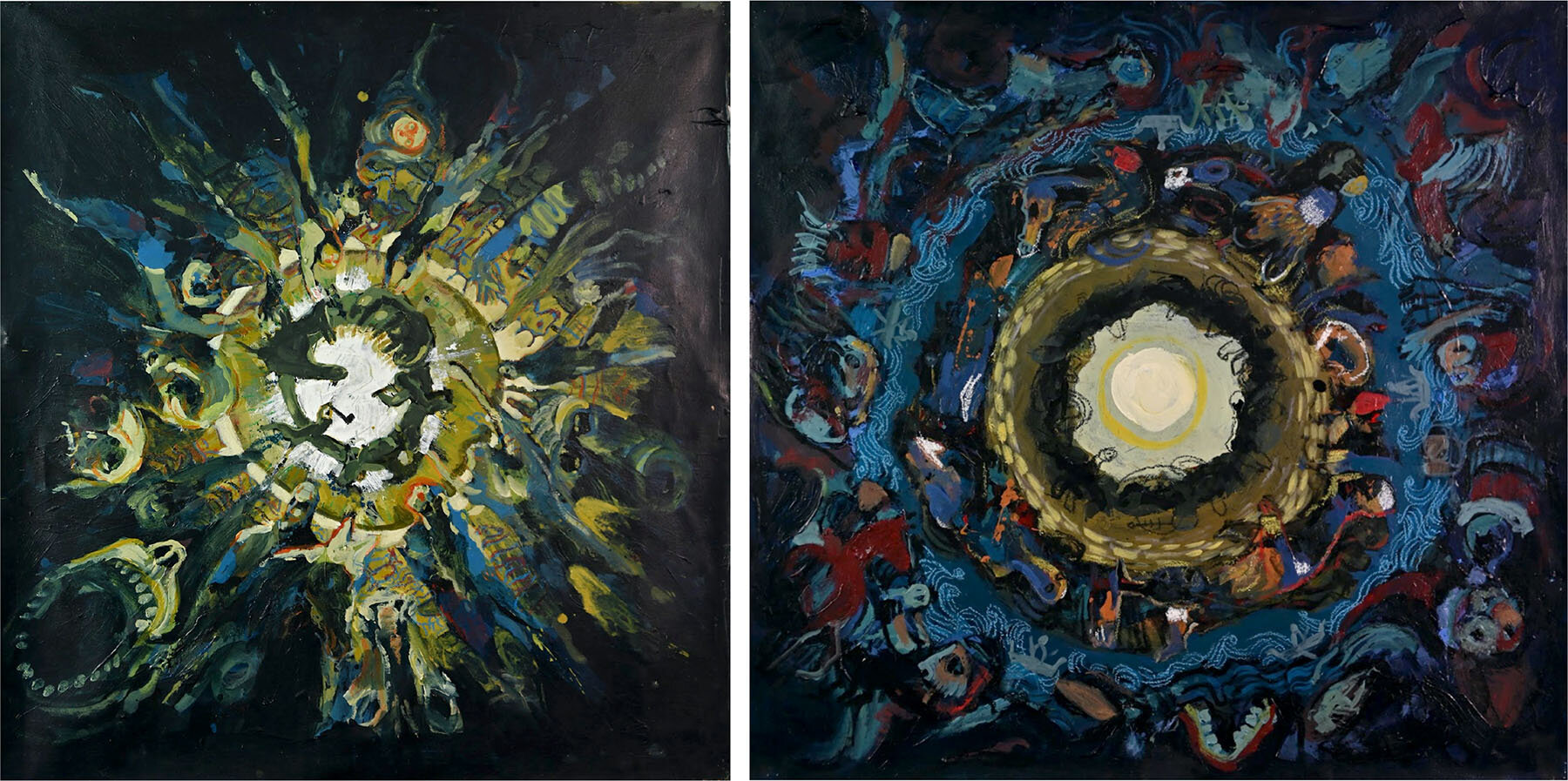
“Crossings of Times,” 2019, oil on canvas, 90 x 90 cm each, Nabil Abu Ghanima.
Nabil Abu Ghanima — Born in Gaza in 1984, Nabil Abu Ghanima received a BA in Art Education from Al-Aqsa University in 2008. He worked as an art teacher, until 2014, when he decided to devote himself to visual art and the illustration of children’s books. He wrote several books for many publishing houses from around the world. He held several personal exhibitions, including “Swallow” (2011), “Freedom from the Sunshades” (2015), and “Paris Open Studio” (2016). In 2010, he obtained an arts residency in Paris for a period of three months at the “International City of Arts” with the support of the French Consulate in Jerusalem and the Qattan Foundation in Palestine.
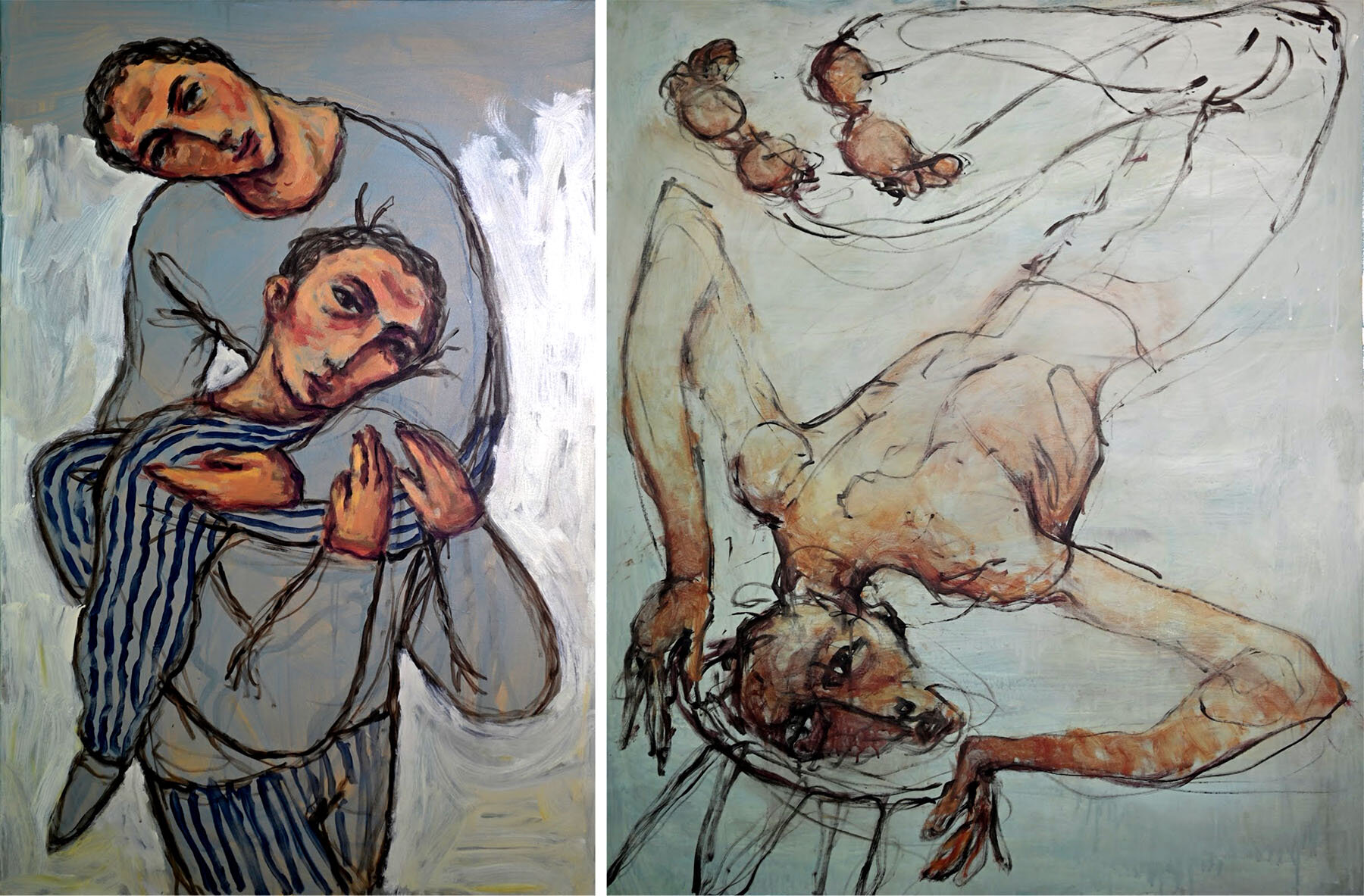
Both “Untitled” from 2020, the first is 80 x 120 and the second 100 x 120cm, Khaled Jarada.
Khaled Jarada — Born in Gaza in 1996, Khaled Jarada holds a BA in multimedia, works as a children’s literature artist, and has many Arab and international participations in the art of children’s literature. Khaled has shown interest in contemporary humanitarian issues and has participated in several contemporary art workshops, as well as local group exhibitions. He is currently working on several contemporary art projects that are concerned with the daily issues of people’s lives.




